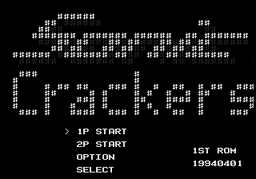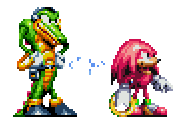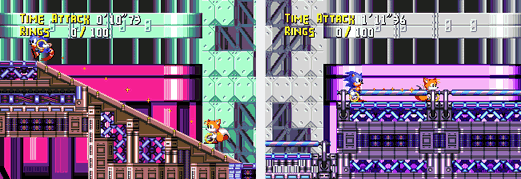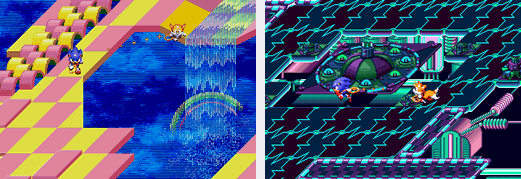Before there was Knuckles Chaotix on the 32X, one last Sonic title was planned for the Genesis. Titled Sonic Crackers, the game was to be the Hedgehog’s swan song on the 16-bit console that he had helped make into such a huge success. He had done a lot on the Genesis, and it would soon be time to move on to Sega’s upcoming 32-bit system for bigger and better things. Unfortunately, the game never made it past the alpha stage and slipped away as nothing more than a footnote in Sonic’s history. It may seem odd that Sega would can a Sonic game, since he was still in top form and able to push systems at a good pace. The truth is that what was to be the hedgehog’s final appearance on the 16-bit wonder was quietly revamped and turned into a new game for the 32X, starring Sonic’s friendly rival Knuckles the Echidna. All the anticipation for a Sonic 4was taken up a notch when the 32X arrived.
 No one suspected this at the time. In fact, the general gaming public was completely unaware that Knuckles Chaotix had its roots in the cancelled game. They merely assumed that the 32X was getting an original title built from the ground up. It wasn’t until a few years ago that enough clues surfaced for the truth to be told. A few ROMs have been seen floating around the internet. One even sold for $146.50 on eBay in 2001. Though no evidence was ever given as to its authenticity, it is rumored to have been sold by a reputable prototype dealer. It is most likely a submission ROM, which were used to show new ideas to management and seek approval. The ROMs are headed as Sonic Stadium, which supports the submissions theory. Many early game prototypes sport false names, in order to maintain secrecy and avoid concept theft from competition. Buggy and prone to crashing for no reason at times, the ROM is believed to be available in two different dumps, a 1MB and a 2MB dump. The only difference is that the 2MB dump contains about half of a prototype Teenage Mutant Ninja Turtles game, although it is unclear which game it is, or if it is even a version of a released game at all.
No one suspected this at the time. In fact, the general gaming public was completely unaware that Knuckles Chaotix had its roots in the cancelled game. They merely assumed that the 32X was getting an original title built from the ground up. It wasn’t until a few years ago that enough clues surfaced for the truth to be told. A few ROMs have been seen floating around the internet. One even sold for $146.50 on eBay in 2001. Though no evidence was ever given as to its authenticity, it is rumored to have been sold by a reputable prototype dealer. It is most likely a submission ROM, which were used to show new ideas to management and seek approval. The ROMs are headed as Sonic Stadium, which supports the submissions theory. Many early game prototypes sport false names, in order to maintain secrecy and avoid concept theft from competition. Buggy and prone to crashing for no reason at times, the ROM is believed to be available in two different dumps, a 1MB and a 2MB dump. The only difference is that the 2MB dump contains about half of a prototype Teenage Mutant Ninja Turtles game, although it is unclear which game it is, or if it is even a version of a released game at all.
Sonic Crackers: Digital Organ Donor
Back in 1994, Sega was squeezing every dime they could from the Sonic franchise. Sonic & Knuckles was on its way, and Sonic 3 had only been released a year before. It was assumed that the other title in progress at the time was the next installment in the series. However, a slowing 16-bit market and the looming next generation prompted Sega to switch platforms in mid-development. The Genesis version was scrapped in favor of a new game featuring Knuckles. Unfortunately, the final product was rushed out in an effort to boost the floundering 32X. Knuckles Chaotix was quickly forgotten by the gaming masses, and the add-on it so desperately tried so save died a quick death.
Crackers was initially rumored to be the basis for Sonic the Hedgehog 4, though many believe this assertion to be false, given that no sprites for Sonic 3 are in the prototype. Sonic 2‘s sprites were instead used as the base. There has also been speculation about the ROM being a hoax, given its compile data is “19940401” (April 1, 1994) on the title screen. Few support this theory, however, and it’s possible that the date could instead be January 4, 1994.
Had it been released on the Genesis, and given more time, Sonic Crackers could perhaps have breathed some new life into the franchise, which had seen little overall innovation since the its debut. In its three short stages, Crackers introduced some interesting gameplay elements that would go on to be featured in subsequent Sonic titles.
The first was the main game dynamic, which had the main characters- Sonic & Tails- tethered together by a “bungie” cord that sported a ring on either end. The purpose of the cord was to allow players to sling themselves around the stages like a slingshot by pressing the jump button at the precise time. In this manner, new areas could be reached. You could also have one of the characters “hold,” allowing you to stretch the cord to increase the power of the slingshot effect. This concept eventually made its way into Knuckles Chaotix, and was still rough enough to cause frustration. How much better it would have worked on the Genesis is unclear, but you have to admit that it was a pretty cool idea at the time. Perhaps it was one of those things that look better on paper than in the final product.
As you can see, the levels themselves are highly reminiscent of those in Chaotix, specifically the Techno Tower and Speed Slider zones. They’re simpler, and lack enemies at this early stage of development. As in Knuckles’ game, each can be played during different times of day, like morning and night. The physics engine is not complete, meaning you can walk up half loops without falling. Pausing the game will also allow you to float around the screen with no arms! Things return to normal when you unpause.
Another Sonic idea that originated with Crackers was the use of isometric fields for movement. It is unclear whether or not they were meant to be special stages or a sort of “world map,” but they were clearly meant to play an integral role in the game itself. The levels in the ROM have no boundaries, and you can maneuver Sonic and Tails just about anywhere. The graphics in these levels are especially good, with some great detail and neat little touches (like the rainbow).
This particular concept would be used as the standard view perspective for Sonic 3D Blast, which was released for the Genesis and Saturn. In addition to the above elements, Sonic Crackers also shares some of the same level design and even a few songs with Knuckle Chaotix. That’s some hefty contributing for a game that never got past the beta stage.
A Rose By Any Other Name…
If you’ve played Chaotix, you’ll probably notice that some of Sonic’s sprites are the same as those of Mighty the Armadillo. This is logical, as they share the same style of movement.
![]()
Sonic had more sprites, which were exclusive to Crackers, including a neat little “drunken” animation that, according to Sega-16 reader Kegan Scowen, ” In the Level similar to Techno Tower, there are spikes on the ceiling at certain areas. If you jump into it as Sonic, Sonic turns into the hit sprite and should get stuck there. Then, pause and move him out of the spikes, and he should land on the ground and start moving left and right, using the “drunken” sprites.”
![]()
Another interesting inclusion is the color palettes used for Sonic and Tails. The top row was used for their heads and bodies, while the bottom one was used for their arms and for linking. Notice, however, the different red and green shades in the bottom row. Could they have been used later for Vector and Knuckle’s sprites in Chaotix?

What Could Have Been
Whenever I think about Sonic Crackers, I find myself wondering if we would have been better off with it, than with 3D Blast and Chaotix. Surely no one would deny that the aforementioned titles failed to set the industry ablaze, or even live up to the standards set by the previous games. It’s entirely possible that had their development time been devoted solely to Crackers, the final product could have been the best Sonic of them all.
Care to see for yourself? Here’s the beta for download, as well as the Gens emulator. Try it out and see exactly what we missed out on!
Sources
- Game Info. Knuckles Chaotix. Green Hill Zone. 2005
- Game Info. Sonic Crackers. Answers.com. 2005.
- Game Info. Sonic Crackers. Secrets of Sonic Team. 2005.
- Game Info. Sonic Crackers. Sonicology. 2005.
- Game Info. Sonic Crackers. Sonic HQ. 2005.




Recent Comments